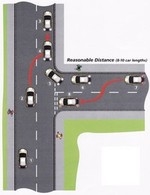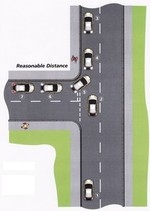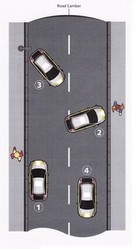Manoeuvres
 Manoeuvering is defined by the DVSA (Driver and Vehicle Standards Agency) as any car movement that involves reversing. We all do it regularly without thinking, such as reversing on or off our driveways, parking behind our neighbour's car or having to turn around when we enter a cul-de-sac by mistake! The manoeuvres required on the driving test are set to simulate these everyday occurrences.
Manoeuvering is defined by the DVSA (Driver and Vehicle Standards Agency) as any car movement that involves reversing. We all do it regularly without thinking, such as reversing on or off our driveways, parking behind our neighbour's car or having to turn around when we enter a cul-de-sac by mistake! The manoeuvres required on the driving test are set to simulate these everyday occurrences.
So, we know you can do them, but can you do them to the standard required on the ADI part 2? Are you doing them correctly, coordinating the controls, making effective observations, and safely? Because many of us have been driving for years, we develop bad habits—habits we may not even know exist—but that now needs to change!
The manoeuvres are as follows:
- Reverse into a side road on the left or the right
- Forward Bay Park
- Parallel park
- Reverse Bay park
 On the ADI part 2 test, you will be expected to carry out the above manoeuvres and either the parallel or bay park (not both!). On the DL25 marking sheet, the examiner (SE) may record faults for either Control or Observation under each heading. As instructors, we teach both and look for accuracy, which would be marked as control if not achieved on the driving test. So, let’s look at these elements and give you a better understanding of how to achieve success.
On the ADI part 2 test, you will be expected to carry out the above manoeuvres and either the parallel or bay park (not both!). On the DL25 marking sheet, the examiner (SE) may record faults for either Control or Observation under each heading. As instructors, we teach both and look for accuracy, which would be marked as control if not achieved on the driving test. So, let’s look at these elements and give you a better understanding of how to achieve success.
Correct co-ordination of the controls.
- Accelerator
- Brakes (including handbrake)
- Clutch
- Steering
Accelerator
Over- or under-revving the engine is poor control. Not setting the gas and relying purely on the clutch—whilst your car may cope with this, it is poor and incorrect control.
Brakes
Harsh braking or late use is incorrect use or coordination. The handbrake should be used to prevent rollback on cambers or secure the car while finding the bite. Holding the footbrake on while doing so is poor coordination and risks a stalled engine.
Clutch
Clutch control is essential to achieving the slow, safe speeds required—not only to ensure safety but also to aid success and accuracy. Raising the clutch too high will build up too much momentum and may require using the brake to slow. If using the brake to slow, the clutch must be dipped below the bite point so that the two pedals are not in conflict—fighting each other!
Steering
We want the car to respond quickly so that we can complete the manoeuvre in the smallest amount of space. Therefore, the least amount of inconvenience will be caused. Full use of the wheel is essential. The driver must be in full control and should not let the wheel slide through the hands freely. Crossing the hands is not necessary, and whilst it may not be marked down, it is not best practice and not a good example to set for your pupils.
Observation
 During any manoeuvre, you must make good, effective observations all around. Pedestrians may not be looking for the reverse lights, paying attention, and not expecting the car to move backwards. They will see a car pointing in a certain direction and choose to walk behind if crossing the road. When looking around, you are not just checking for approaching vehicles but also for pedestrians, so footpaths are just as important.
During any manoeuvre, you must make good, effective observations all around. Pedestrians may not be looking for the reverse lights, paying attention, and not expecting the car to move backwards. They will see a car pointing in a certain direction and choose to walk behind if crossing the road. When looking around, you are not just checking for approaching vehicles but also for pedestrians, so footpaths are just as important.
You must always look in the direction of travel!
Modern cars have smaller windows, and visibility to the rear may be restricted so mirrors can be used. However, this should be purely to check the car's position and only glance. Even with restricted vision, you MUST look directly in the direction of travel. Your eyes have a greater field of vision (peripheral) and will spot movement; mirrors do not!
As a guideline, before reversing in a straight line or to the left, you should check the right blind spot for pedestrians on the opposite footpath and for vehicles approaching from behind. Then start to sweep to the left, checking all the mirrors and the road ahead, ending by looking out of the rear windscreen.
When reversing to the right, begin with the left blind spot and sweep to the right, ending by looking directly out the rear right passenger door window.
The above is a guideline only. Observations should be where required throughout the manoeuvre and not carried out regimentally. Effective observation is not just looking! It is about acting on what you see! A good tip is to lower the door windows if the weather permits, allowing you to listen to and hear any approaching vehicles.
Accuracy
The examiner is not looking for perfection. So, what does accuracy mean? How is it marked if there is no box on the DL25 on these manoeuvres?
Lack of accuracy is marked as control! This is considered to be the only cause of the fault.
Left Reverse and Right reverse (Not required but should be taught)
Keep the car close to the kerb throughout the exercise (no more than 10 cm). On completion, the car should be no further out than a maximum drain width. A control fault may be recorded should you need to correct it to achieve this.
Parallel Park
The manoeuvre must be completed within one and a half car lengths from the target vehicle. It should be no more than four to eight inches from the curb and finish parallel. If you need to correct this, a control fault will be recorded.
Bay Park
The car must finish clear of the white lines and as straight as possible. If you do find yourself too close or on a white line, then a correction of one shunt forward is permitted. However, this would result in a control fault.
Turn in the road (Not required but should be taught)
The examiner will expect you to complete the manoeuvre in the minimum number of turns. If the width of the road is the same or greater than one and a half times the length of your vehicle, then it is achievable in three turns. Completing it in five would result in a control fault.
Make sure you fully understand the requirements of all the manoeuvres to get you the pass you seek!
 Twitter
Twitter Facebook
Facebook Linkedin
Linkedin